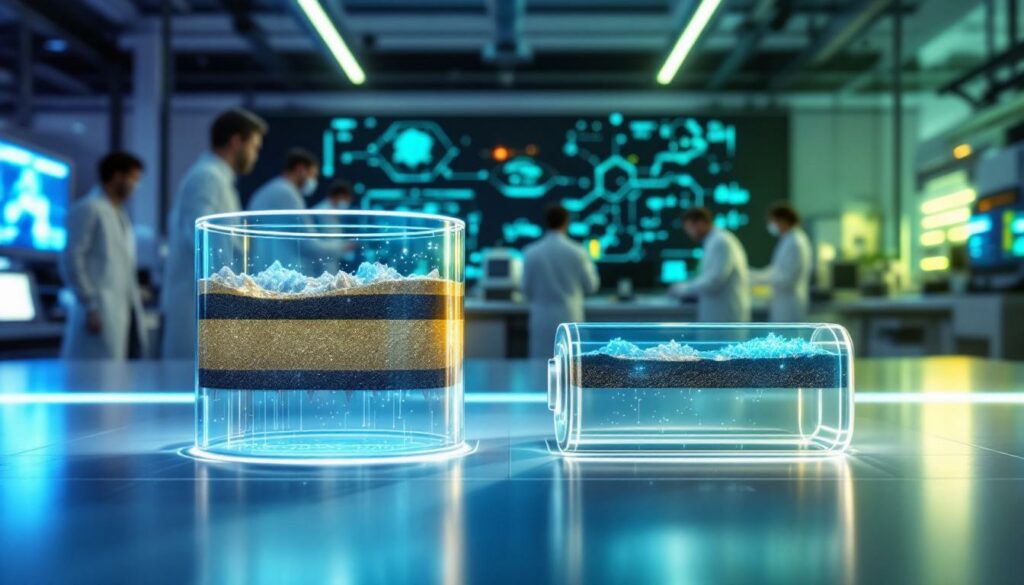CATL's Breakthrough in Lithium-Metal Battery Technology: Revolutionizing Energy Storage
Lithium-metal battery technology is experiencing a renaissance, with Contemporary Amperex Technology Co. Limited (CATL) leading the charge toward commercial viability. The Chinese battery giant has recently achieved remarkable progress in extending the cycle life of high-energy-density lithium-metal batteries, potentially transforming electric vehicles, aviation, and energy storage sectors.
What Are Lithium-Metal Batteries and Why Are They Important?
The Fundamental Difference from Lithium-Ion Batteries
Lithium-metal batteries represent a significant evolution beyond traditional lithium-ion technology. Rather than using graphite-based anodes, these advanced batteries employ pure lithium metal, creating a fundamental architectural difference that delivers substantial performance benefits. The lithium-metal anode is approximately 90% lighter than conventional graphite anodes, dramatically reducing weight while simultaneously improving charging and discharging efficiency.
This structural change eliminates the need for the "host material" that stores lithium ions in conventional batteries, allowing for direct use of lithium in its most energy-dense form. The result is a battery that can pack significantly more energy into the same volume and weight.
The Promise of Higher Energy Density
The most compelling advantage of lithium-metal batteries is their exceptional energy density. While today's commercial lithium-ion batteries typically achieve 250-300 Wh/kg, CATL's lithium-metal technology has demonstrated energy densities reaching 500 Wh/kg—nearly doubling current capabilities. This represents a transformative leap forward for applications where weight and space constraints are critical limitations.
To put this advancement in perspective, lithium metal has a theoretical specific capacity of 3,860 mAh/g, which dwarfs graphite's modest 372 mAh/g. This tenfold improvement in theoretical capacity explains why battery researchers have pursued this technology for decades despite significant challenges.
"Lithium-metal technology represents the holy grail of battery chemistry—the highest theoretical energy density with the lightest possible anode material," explains materials scientists at the U.S. Department of Energy, which has invested heavily in lithium-metal research through its Battery500 Consortium.
Historical Commercialization Challenges
Despite their compelling theoretical advantages, lithium-metal batteries have faced persistent commercialization hurdles for over 40 years, including:
- Dendrite formation – Uneven lithium deposition during charging creates branch-like structures that can penetrate separators, causing short circuits and potential safety hazards
- Limited cycle life – Early lithium-metal cells typically degraded after fewer than 100 cycles, making them impractical for commercial applications
- Electrolyte instability – Reactive lithium metal continuously consumes electrolyte components, leading to capacity loss and internal resistance growth
- Manufacturing complexity – Ultra-dry production environments (dew points below -50°C) are required to prevent lithium degradation during cell assembly
- Safety concerns – Lithium metal's high reactivity introduces additional safety management challenges compared to graphite-based systems
These obstacles have kept lithium-metal batteries largely confined to laboratory settings—until now.
How Has CATL Advanced Lithium-Metal Battery Technology?
Breakthrough Cycle Life Achievements
CATL's recent research breakthrough has shattered previous limitations in lithium-metal battery longevity. Their latest prototypes have demonstrated 483 cycles while maintaining their impressive 500 Wh/kg energy density—more than doubling the lifespan of previous lithium-metal battery iterations.
This achievement represents a critical milestone on the path toward commercial viability. While still below the 1,000+ cycles typically required for automotive applications (according to U.S. Advanced Battery Consortium targets), it marks substantial progress toward making lithium-metal technology practical for real-world use.
The cycle life improvement has been achieved without compromising the technology's primary advantage—energy density—making it a true breakthrough rather than a performance trade-off.
The Electrolyte Salt Concentration Discovery
Perhaps the most significant aspect of CATL's advancement is the identification of the primary degradation mechanism in lithium-metal batteries. Through meticulous analysis at its 21C Lab, CATL researchers discovered that the dominant factor limiting cycle life isn't what previous research had suggested.
Rather than solvent breakdown, dead lithium accumulation, or solvation environment disruption, CATL's team identified that the continuous consumption of the electrolyte salt LiFSI (lithium bis(fluorosulfonyl)imide) is the critical failure mode. Their research revealed that approximately 71% of this vital salt depletes by the end of the battery's service life.
"Our findings demonstrate that LiFSI salt consumption and overall salt concentration are fundamental determinants of battery longevity," states Ouyang Chuying, CATL's Co-President of R&D and deputy director of 21C Lab.
This discovery has profound implications for battery design, as it redirects focus from other degradation mechanisms that have consumed research attention for decades.
Novel Analytical Methodologies
To achieve this breakthrough understanding, CATL developed proprietary analytical techniques that precisely quantify the consumption of active lithium and electrolyte components during cycling—an exceptionally difficult task given the reactive nature of the materials involved.
These methodologies include:
- Advanced chemical separation techniques to isolate degradation products
- Spectroscopic analysis to identify chemical signatures of decomposition
- Quantitative measurement of electrolyte component concentrations throughout battery life
- Correlation of salt depletion with electrochemical performance metrics
This comprehensive analytical approach has enabled researchers to identify root causes of rapid degradation in lithium-metal batteries that had previously eluded the scientific community, despite decades of investigation.
What Makes CATL's Research Approach Unique?
The 21C Lab's Integrated Research Model
CATL's findings emerged from its dedicated 21C Lab, an innovation center specifically focused on next-generation battery technologies. Unlike typical corporate R&D departments, the 21C Lab operates with a unique mandate to pursue fundamental scientific understanding alongside practical commercial applications.
This facility bridges the gap between academic research and industrial implementation, allowing CATL to rapidly translate theoretical advances into testable prototypes. The lab has published more than 15 peer-reviewed papers in 2024 alone, demonstrating its commitment to scientific rigor alongside commercial development.
The integration of basic science with manufacturing expertise has proven critical for lithium-metal battery advancement, as many previous academic discoveries failed when scaled to practical cell formats.
Substantial R&D Investment
CATL's breakthrough isn't accidental—it represents the fruits of massive, sustained investment in battery innovation. The company allocated approximately 18.6 billion yuan (€2.28 billion) to research and development in 2024 alone, making it one of the world's largest investors in advanced battery technology.
This financial commitment has yielded over 43,000 patents granted or applied for worldwide, establishing CATL as an intellectual property leader in energy storage. The company's R&D spending has grown consistently year over year, reflecting its strategic focus on maintaining technological leadership.
| Year | CATL R&D Investment (Billion Yuan) |
|---|---|
| 2020 | 5.9 |
| 2021 | 8.2 |
| 2022 | 10.8 |
| 2023 | 15.4 |
| 2024 | 18.6 |
This table illustrates CATL's escalating commitment to innovation, with R&D investment more than tripling in just five years.
Interdisciplinary Scientific Approach
CATL's research team published their lithium-metal findings in the prestigious journal 'Nature Nanotechnology' under the title 'Application-driven design of non-aqueous electrolyte solutions through quantification of interfacial reactions in lithium metal batteries.' This high-impact publication highlights the company's commitment to rigorous scientific methodology and peer review.
The interdisciplinary approach combines:
- Electrochemistry and materials science fundamentals
- Advanced analytical chemistry techniques
- Engineering and manufacturing expertise
- Computational modeling for mechanistic understanding
This holistic approach has allowed CATL to develop insights that more narrowly focused research efforts have missed, particularly regarding the critical role of electrolyte salt dynamics.
How Does CATL's Work Compare to Competitors' Research?
The Global Race for Lithium-Metal Innovation
CATL isn't alone in pursuing lithium-metal battery advancements. A global race is underway to commercialize this promising technology, with several major players making significant investments:
- LG Energy Solution has partnered with the Korea Advanced Institute of Science and Technology (KAIST) to develop borate-pyran-based liquid electrolytes for lithium-metal batteries
- SES AI Corporation has developed hybrid lithium-metal technology reportedly achieving 400 Wh/kg in prototype cells
- QuantumScape is pursuing solid-state electrolytes to enable lithium-metal anodes
- Solid Power focuses on sulfide-based solid electrolytes for lithium-metal compatibility
- Blue Solutions has commercialized lithium-metal polymer batteries, albeit at lower energy densities than CATL's latest prototypes
Each company pursues distinct technical approaches, creating a diverse competitive landscape with multiple potential paths to commercial success.
Competitive Differentiation in Electrolyte Design
What distinguishes CATL's approach is its focus on understanding and addressing the fundamental salt concentration dynamics throughout the battery's lifecycle. While competitors primarily focus on optimizing solvation structures or developing solid-state electrolytes, CATL has identified the critical role of salt depletion as the limiting factor in battery longevity.
This novel perspective provides CATL with a unique advantage: the ability to design electrolyte systems specifically addressing the primary failure mechanism, rather than secondary degradation pathways. By focusing on preserving electrolyte salt concentration, CATL can potentially achieve further cycle life improvements while maintaining high energy density.
The company's integration of computational modeling with experimental validation also accelerates development compared to purely empirical approaches used by some competitors.
What Are the Potential Applications for CATL's Lithium-Metal Batteries?
Electric Vehicle Implementation Potential
The high energy density of CATL's lithium-metal batteries could significantly transform electric vehicle capabilities. With 500 Wh/kg energy density—nearly double today's commercial cells—these batteries could potentially enable EVs with ranges exceeding 1,000 kilometers on a single charge without increasing battery weight or size.
This advancement addresses one of the most persistent consumer concerns about electric vehicles: range anxiety. By significantly extending range without adding weight, lithium-metal technology could accelerate EV adoption, particularly for consumers requiring long-distance travel capabilities.
Additionally, the reduced weight could improve vehicle efficiency, handling, and acceleration while potentially reducing structural requirements. For commercial vehicles, increased energy density translates directly to greater payload capacity or extended range—both critical economic factors.
Electric Aviation Opportunities
Perhaps the most transformative potential for lithium-metal batteries lies in aviation applications, where weight is paramount. Current lithium-ion batteries are generally too heavy for practical electric aircraft beyond small experimental vehicles, with the Federal Aviation Administration typically requiring energy densities exceeding 400 Wh/kg for commercial viability.
At 500 Wh/kg, CATL's technology crosses this critical threshold, potentially enabling:
- Electric regional aircraft with 250-500 mile ranges
- Hybrid-electric systems for larger commercial aircraft
- Extended-range electric vertical takeoff and landing (eVTOL) air taxis
- Unmanned aerial vehicles with significantly improved flight times
The aviation sector represents a high-value initial market for lithium-metal technology, as the weight advantages justify premium pricing compared to ground transportation applications.
Grid Storage Possibilities
Beyond transportation, high-density lithium-metal batteries could transform grid storage economics by reducing space requirements and potentially lowering costs per kilowatt-hour of stored energy.
While energy density is less critical for stationary applications than for vehicles, the potential for extended cycle life through optimized electrolyte salt management could make lithium-metal batteries attractive for grid applications requiring frequent cycling. Additionally, the technology's high energy density could prove valuable in space-constrained urban environments where land costs are significant.
What Technical Challenges Remain for Lithium-Metal Battery Commercialization?
Manufacturing Scale-Up Considerations
Transitioning from laboratory prototypes to mass production presents significant engineering challenges. Lithium-metal battery manufacturing requires:
- Ultra-dry production environments – Dew points below -50°C to prevent lithium degradation
- Specialized handling equipment – To safely process reactive lithium metal foils
- Precise electrolyte formulation – To maintain consistent salt concentrations identified as critical by CATL
- Modified formation protocols – To establish stable solid-electrolyte interphase layers
- Enhanced quality control systems – To detect potential defects that could lead to dendrite formation
These manufacturing considerations require substantial capital investment and process development before high-volume production becomes feasible.
Safety Enhancement Requirements
Lithium metal's high reactivity presents inherent safety challenges that must be addressed before widespread commercialization. CATL's research into electrolyte dynamics represents one aspect of the comprehensive safety approach required.
Additional safety considerations include:
- Mechanical protection against external puncture or damage
- Thermal management systems to prevent runaway reactions
- Advanced battery management systems for early detection of potential issues
- Fail-safe mechanisms to isolate cells in case of anomalies
- Compliance with evolving international safety standards like UN 38.3
Disclaimer: Battery safety development is an ongoing process. While significant advances have been made, all high-energy battery systems carry inherent risks that require proper engineering controls and safety systems.
Long-Term Stability Testing Needs
While 483 cycles represents significant progress, commercial applications typically require thousands of cycles. The U.S. Advanced Battery Consortium targets 1,000+ cycles for automotive applications, with grid storage often requiring 3,000+ cycles for economic viability.
Additional research into extending cycle life while maintaining high energy density remains a priority. CATL's identification of salt depletion as the primary limiting factor provides a clear path forward, but translating this understanding into batteries with 1,000+ cycle lifespans requires further optimization and validation.
Long-term testing under varied environmental conditions, charge rates, and discharge profiles is essential before commercial deployment, particularly for safety-critical applications like aviation.
How Might CATL's Findings Impact the Future Battery Landscape?
Potential Timeline for Commercial Implementation
Based on current development trajectories and historical battery commercialization patterns, lithium-metal batteries incorporating CATL's electrolyte innovations could potentially reach market within 3-5 years, following this approximate timeline:
- 2025-2026: Advanced prototypes and small-scale pilot production
- 2026-2027: First commercial applications in premium, niche markets (likely aviation or specialty vehicles)
- 2027-2028: Expanded production capacity and initial mainstream applications
- 2028-2030: Potential widespread adoption if cost targets are achieved
Initial deployments will likely target high-value applications where the performance advantages justify premium pricing, with mass-market adoption following as manufacturing scales and costs decrease.
Implications for Battery Industry Standards
CATL and lithium-metal batteries may significantly influence industry-wide testing standards and research priorities. Current battery testing protocols often focus on parameters like electrode degradation and impedance growth without specifically measuring electrolyte component consumption.
The company's findings suggest that standardized methods for quantifying electrolyte salt depletion could become essential for evaluating next-generation battery technologies. This could reshape how battery manufacturers approach quality control and lifetime prediction.
Industry organizations like the International Electrotechnical Commission (IEC) and battery consortia may need to develop new standards incorporating these insights, potentially accelerating overall progress in advanced battery recycling breakthrough technologies.
Environmental and Resource Considerations
The shift to lithium-metal anodes will alter resource demand patterns in the battery supply chain. Potential impacts include:
- Reduced graphite requirements – Eliminating graphite anodes could decrease demand for this material, affecting mining operations in major producing countries like China
- Increased demand for high-purity lithium metal – Current lithium production primarily focuses on lithium compounds rather than pure metal, requiring process adaptations
- Different electrolyte materials – Higher consumption of LiFSI salt could shift production toward this specialized electrolyte component
- Potential for increased recyclability – Lithium metal's high value could improve recycling economics compared to graphite-based systems
These supply chain shifts would have implications for mining operations, refining capacity, and recycling infrastructure globally, requiring strategic planning by materials suppliers and battery-grade lithium refinery operators worldwide.
FAQ About CATL's Lithium-Metal Battery Technology
What energy density do CATL's lithium-metal batteries achieve?
CATL's lithium-metal batteries have demonstrated an energy density of 500 Wh/kg, approximately double the energy density of conventional lithium-ion batteries currently in commercial use. This represents one of the highest verified energy densities for rechargeable batteries with substantial cycle life.
How many cycles can CATL's lithium-metal batteries complete?
The latest prototypes have achieved 483 cycles while maintaining performance, which is twice the cycle life of previous lithium-metal battery prototypes. While this represents significant progress, further improvements are needed to meet the 1,000+ cycles typically required for automotive applications.
What is the primary cause of failure in lithium-metal batteries according to CATL's research?
Contrary to previous theories focusing on dead lithium or solvent degradation, CATL has identified that the continuous
Ready to Get Ahead of the Next Mineral Discovery?
Discover significant ASX mineral discoveries the moment they happen with Discovery Alert's proprietary Discovery IQ model, transforming complex geological data into actionable investment insights. Visit the Discovery Alert discoveries page to understand why major mineral discoveries can lead to substantial market returns and begin your 30-day free trial today.




